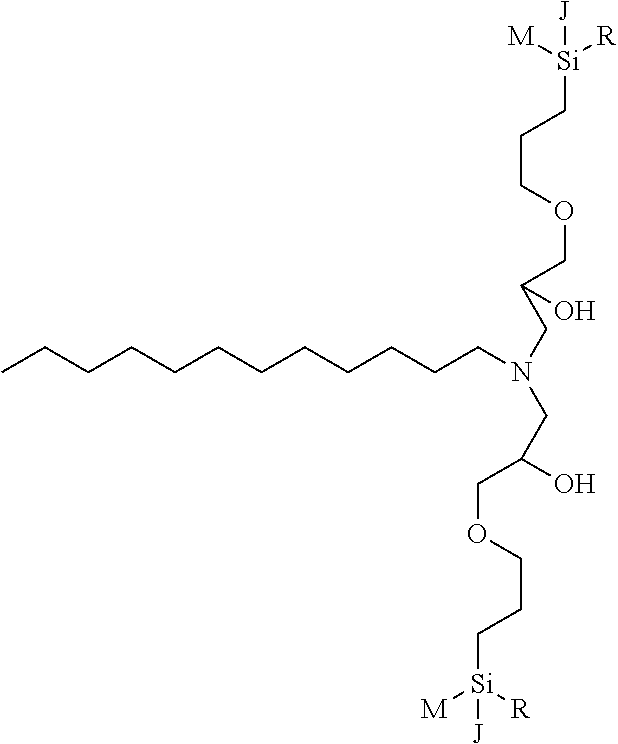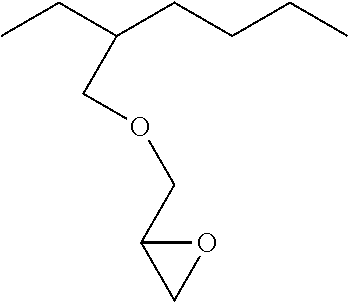Reducing aluminosilicate scale in the bayer process
a technology of aluminosilicate and bayer process, which is applied in the field of matter composition, can solve the problems of affecting liquor throughput, affecting liquor throughput, and affecting the recycling of liquor within the fluid circuit, so as to reduce the amount of siliceous scale
- Summary
- Abstract
- Description
- Claims
- Application Information
AI Technical Summary
Benefits of technology
Problems solved by technology
Method used
Image
Examples
example 1
[0053]Polypropylene bottles and a temperature controlled rotary water bath were used under isothermal conditions for batch desilication experiments. Synthetic spent Bayer liquor was prepared on the same day or one day prior to the experiment. Typical analysis for the synthetic liquor used was:
Alumina (A): 84.62 g / L as Al2O3;
Caustic (C): 238.42 g / L as Na2CO3;
Ratio of A to C, 0.355.
[0054]A series of tests were conducted by adding the specified dose of TG14 and DG12 to the bottles containing synthetic spent Bayer liquor (150-200 mL). The synthetic liquor was heated in the water bath and as the desired temperature (95° C.) was reached, sodium metasilicate solution was added. (A calculated amount to give the starting SiO2 concentration of 0.05M was added.) The resulting solutions were heated and held at 95° C. for the duration of the test (4 hours). Final solutions were filtered through a 0.45 μm membrane to collect solids, which were washed with hot de-ionized water and air-dried. Table...
example 2
[0056]A series of further tests were conducted in a similar manner to that described in example 1 using Bayer process liquor from two operational refineries. In these and subsequent examples the following method was employed:
[0057]To a series of polypropylene bottles containing plant spent liquor (200 mL each), a 20 mL sample of 117 g / L Na2SiO3. 5H2O solution was added (3.0 g / L as SiO2). To selected bottles, a specified dose of individual inhibitor product was also added. Duplicate bottles for each dose of each inhibitor were used, together with duplicate undosed control samples in each test. The resulting liquor mixtures were heated in a rotating water bath with temperature held constantly at 95° C. throughout the duration of the test (4 hours) so as to induce precipitation of DSP. After 4 hours, the contents of each bottle were individually filtered to collect the solids, which were washed with hot de-ionized water and dried at room temperature overnight. The effectiveness of the ...
example 3
[0061]Similar tests were conducted to assess the effect of reagents comprising the reaction products of 1) a small molecule amine, 2) an amine reactive silane and 3) an amine reactive hydrophobe. The method used was the same as that described in example 2 and reagents used to produce the active components are listed in table 3 together with the activity as measured by percent of DSP precipitated compared to an undosed control sample.
[0062]Again, in all cases the precipitation of DSP is reduced by addition of the reaction products as specified, indicating that inhibition of DSP precipitation is achieved by application of the relevant small molecules to the Bayer liquor.
[0063]Nomenclature used in Table 3 is the same as that used for Table 2 with the addition of:
ED=N-[3-(Trimethoxysilyl)propyl]ethylenediamine
P=4-nonylphenolglycidyl ether
E=2-Ethylhexylglycidyl ether
H=1,6-Hexanediamine
[0064]
TABLE 3Inhibition of DSP by small molecule adductsof amine / silane / hydrophobe reaction.Amine-Produc...
PUM
| Property | Measurement | Unit |
|---|---|---|
| molecular weight | aaaaa | aaaaa |
| molar ratio | aaaaa | aaaaa |
| temperature | aaaaa | aaaaa |
Abstract
Description
Claims
Application Information
 Login to View More
Login to View More - R&D
- Intellectual Property
- Life Sciences
- Materials
- Tech Scout
- Unparalleled Data Quality
- Higher Quality Content
- 60% Fewer Hallucinations
Browse by: Latest US Patents, China's latest patents, Technical Efficacy Thesaurus, Application Domain, Technology Topic, Popular Technical Reports.
© 2025 PatSnap. All rights reserved.Legal|Privacy policy|Modern Slavery Act Transparency Statement|Sitemap|About US| Contact US: help@patsnap.com



